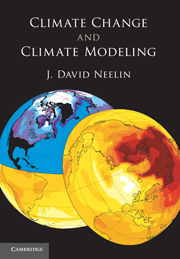Book contents
- Frontmatter
- Contents
- Preface
- 1 Overview of climate variability and climate science
- 2 Basics of global climate
- 3 Physical processes in the climate system
- 4 El Niño and year-to-year climate prediction
- 5 Climate models
- 6 The greenhouse effect and climate feedbacks
- 7 Climate model scenarios for global warming
- Glossary
- References
- Index
4 - El Niño and year-to-year climate prediction
Published online by Cambridge University Press: 05 June 2012
- Frontmatter
- Contents
- Preface
- 1 Overview of climate variability and climate science
- 2 Basics of global climate
- 3 Physical processes in the climate system
- 4 El Niño and year-to-year climate prediction
- 5 Climate models
- 6 The greenhouse effect and climate feedbacks
- 7 Climate model scenarios for global warming
- Glossary
- References
- Index
Summary
Recap of El Niño basics
Chapter 1 provided a view of the essential features of the El Niño/Southern Oscillation phenomenon, or ENSO, as observed in the tropical Pacific Ocean. ENSO involves variations about the average climate (termed anomalies) in the sea surface temperature (SST), convection zones, atmospheric pressure gradients and winds, thermocline depth and upper ocean currents. The relation between these variables indicate that El Niño and the Southern Oscillation are connected phenomena. There are indications of oscillatory behavior with a 3- to 5-year preferred time scale, although also considerable irregularity in the behavior. In this chapter, the physical mechanisms relating these variables are discussed in more detail using some of the tools developed in Chapter 3. First the mechanisms for maintaining a fully developed El Niño (warm) or La Niña (cold) phase are discussed, followed by the mechanism for alternation between the extreme phases.
While the heart of ENSO lies in the tropical Pacific, impacts in other parts of the world are also important. Such remote effects of El Niño or La Niña are termed teleconnections. These are essentially by-products of the changes in the tropical Pacific. This would include changes in temperature and rainfall over the USA, South America, Australia, Southeast Asia and India, and Africa. Although these are effects we are interested in, prediction of these effects is often less reliable than that of the El Niño itself. After treating the dynamics and basis for predictability of the main part of ENSO, we discuss mechanisms for teleconnections in section 4.8.
- Type
- Chapter
- Information
- Climate Change and Climate Modeling , pp. 103 - 144Publisher: Cambridge University PressPrint publication year: 2010



